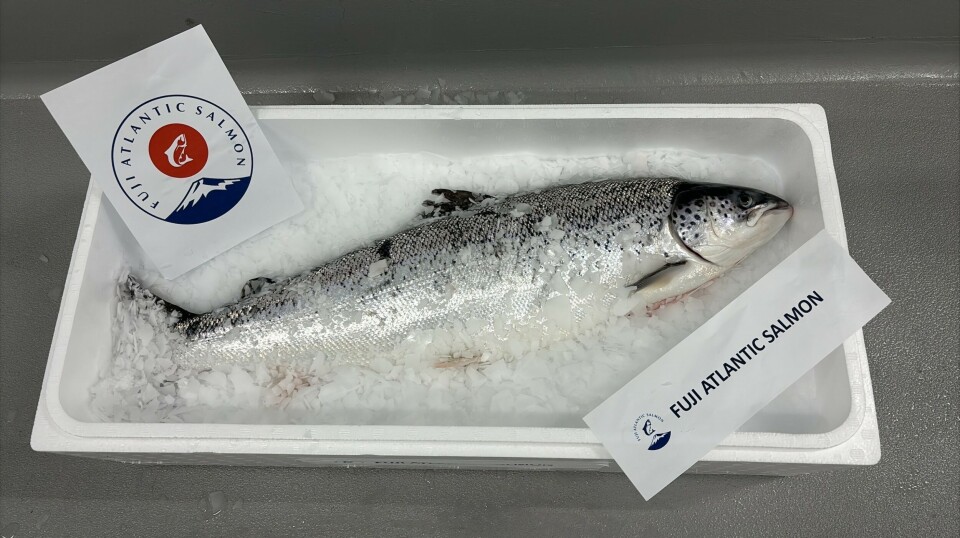
Proximar Seafood held back by low average harvest weight in Q3
Challenges with the biofilter last year have impacted the Japan salmon farmer through 2025 as a result of reduced feeding. Now Proximar will push back harvest dates to get fish weights up.
Proximar Seafood AS reports in its Q3 report that it is now making good progress towards its target of having approximately 2,000 tonnes of biomass by the end of the year.
“We are pleased to now see improved operating conditions yielding results, with low natural mortality and improved growth rates,” said chief executive Joachim Nielsen.
He said Proximar expects production to gradually return to the right track into 2026, combined with what he sees as a positive market picture and attractive price levels.
Proximar harvested 356 tonnes (head on gutted) in Q3 2025, with an average weight of 2.3 kg. The superior share was 99.2%, with a survival (including incidents) of over 99% in the food fish department. According to Nielsen, most of the mortality that has occurred has been related to the transport of fish.
The facility has harvested 1,200 tonnes HOG since September 2024.
Nielsen said the company is optimistic when looking towards 2026.
“We are now seeing growth picking up, and we plan to push some volumes into 2026 as a measure to increase average harvest weight and achieve better prices,” he added.
Reduced feeding and insurance payout
The third quarter was affected by a long period of lower average weight of harvested fish and thus lower price realisation, mainly as a result of reduced feeding following biofilter incidents in Q4 2024. But other reasons also played a role:
- Extensive transfers in July after repairs to the last module were completed
- Problems with the feeding system and feed distribution
- Elevated water temperatures after a heat wave in Japan throughout the summer
According to the company, extensive measures have been implemented to improve operating conditions, including:
- Improvements to the feeding system, increased pump capacity and replacement of parts that were not working
- Improved feed distribution to reduce feed waste and ensure better feeding
- Long-term rental of additional cooling capacity that is secured and connected
Revenue for the quarter ended at NOK 24.0 million, compared to NOK 0.15 million in Q3 2024.

EBITDA, a measure of operting profit, was NOK -7.3 million, compared to NOK -1.7 million in Q3 2024.
According to the stock exchange release, operating profit was positively affected by one-time payments from insurance of NOK 16.4m in the quarter, related to the biofilter incidents in Q4 2024 and the mortality incident in May 2025.
More measures
Throughout the quarter, the company has implemented several measures to improve growth.
“The measures have yielded positive results into October and November, and feeding volumes are now following plan, with growth rates in line with expectations.”

Better prices than imported salmon
For market-ready fish over 3 kg HOG that were harvested by Proximar Seafood in Q3 2025, the average price achieved was NOK 97 per kilo net.
“This demonstrates the significant advantage of local production in Japan. Fuji Atlantic salmon continues to command premium prices in this segment, compared to an average export price from Norway of NOK 69/kg in the quarter,” Proximar wrote.
The total average price Proximar achieved in Q3 2025 was NOK 67/kg, influenced by a large proportion of the fish being under 3 kg (HOG).
The company said that Japan's increased focus on food security was underlined by Prime Minister Sanae Takaichi's support for land-based farming in her policy speech in October.
“With limited domestic production and strong consumer preferences for premium seafood, land-based production has strong underlying drivers for long-term domestic demand,” said Proximar.
Balance sheet strengthened
The company entered Q4 2025 with a strengthened balance sheet following the completion of the refinancing plan in October 2025 which involved two transactions:
1. An issue of NOK 150 million
2. Conversion of a convertible loan of around NOK 200 million into equity
Furthermore, agreements were entered into for parts of the company's debt with original maturity in 2025, where the syndicated loan has been extended to August 2026 and the shareholder loan to October 2027.
Outlook for 2025 and 2026
With full production capacity restored and a stronger financial position, the company now expects gradually increasing harvest weights and better price realisation going forward.
“The main priority is to get on schedule for 2026, with a goal of average harvest weights above 3.5 kg HOG.”
The total number of fish planned to be harvested in 2025 is approximately 550,000 and 1,250,000 in 2026, as the production plan is adjusted to optimise harvest weights and extract premium prices for market-ready fish as well as increased volumes.
Some fish are planned to be moved from December 2026 to January 2027 for market reasons, which explains the deviation of around 100,000 fish from previous guidance for the total number of harvested fish in 2025 and 2026.






















